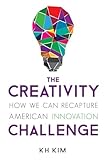The creativity challenge : how we can recapture American innovation / Kyung-Hee Kim.
Language: English Publication details: Amherst, New York : Prometheus Books, 2016.Description: 351 pages : illustration ; 23 cmISBN:- 9781633882157
- 1633882152
- BF 408 K49c 2016
| Item type | Current library | Home library | Collection | Shelving location | Call number | Copy number | Status | Date due | Barcode |
|---|---|---|---|---|---|---|---|---|---|
 Libro
Libro
|
Biblioteca Juan Bosch | Biblioteca Juan Bosch | Humanidades | Humanidades (4to. Piso) | BF 408 K49c 2016 (Browse shelf(Opens below)) | 1 | Available | 00000174441 |
Includes index
Part 1. What is creativity? The creativity crisis
The creativity solution
Part 2. What are creative climates and attitudes? The soil climate that nurtures the soil attitudes
The Sun climate that nurtures the Sun attitude
The storm climate that nurtures the storm attitudes
The space climate that nurtures the space attitudes
Part 3. How do cultural climates affect creativity? Are men really more creative than women are?
Are Jews really more creative than Asians are?
Part 4. What are the creative-thinking skills? ION thinking skills (Inbox, Outbox, and New box) with the ACP (Apple-Tree Creative Process)
American creativity has steadily declined since 1990. That disturbing trend recently came to light through the work of leading educational psychologist KH Kim, a recognized expert in creativity assessment. In this insightful and inspiring book, Kim discovers the causes of the decrease in creativity and proposes methods of recapturing American creativity in education, in industry, and throughout every sector of society. Through the life stories of innovators, Kim debunks the assumption that creative people must be born with innate talents. She shows how parents, educational methods, and cultures shaped innovators' creative expression. As her research clearly indicates, cultural climates and attitudes (including over-reliance on standardized testing) often work against innovation unless creativity is deliberately grown and developed. Culminating over twenty years of extensive research, Kim has devised original models to identify creativity in people and organizations and help it to blossom. Gardening metaphors illustrate simple but powerful steps to transform creative potential into innovation. She emphasizes practical steps to cultivate creative climates (environment) in schools, in homes, and at work; nurture creative attitudes (personality) toward learning, work, and life; and apply creative thinking skills. Kim's models for creativity are complemented with evidence-based methods to learn and practice creative skills in everyday life"-- Provided by publisher


There are no comments on this title.